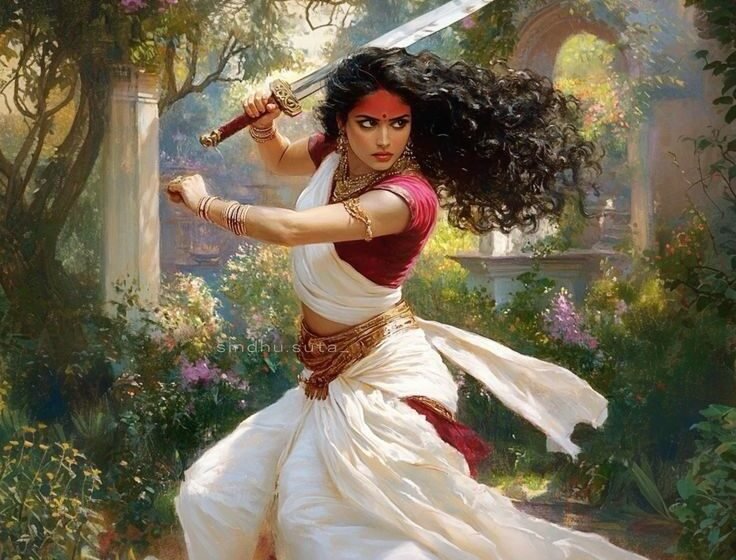The Forgotten Indian Female Warriors: Unsung Heroes of Medieval India

-Mili Joshi
The Forgotten Indian Female Warriors: Unsung Heroes of Medieval India
When we think of India’s history, we often picture mighty kings, grand forts, and famous battles. But behind these stories stand many brave women whose names never made it to our textbooks. These women fought invaders, protected kingdoms, and ruled with iron wills. Yet, most of us have never heard their names.
It’s time we remember them.
Why Do We Forget Our Warrior Queens?
Indian history is full of kings and male generals. But medieval India also saw many women pick up the sword. Some ruled alone. Some led armies alongside their husbands or fathers. Some defended their lands till their last breath.
Colonial historians and court chroniclers often ignored these women. Oral traditions kept some names alive. But many faded into footnotes.
Let’s bring a few of these fierce women back into the light.
1. Rani Durgavati — The Gond Queen Who Faced the Mughals
Rani Durgavati was born in 1524. She became queen of the Gondwana kingdom in central India after her husband’s death. When Emperor Akbar’s Mughal army attacked in 1564, she chose to fight.
Outnumbered and outgunned, Durgavati led her soldiers into battle. She rode an elephant into the thick of war. Even when wounded by arrows, she kept fighting. Realising defeat was certain, she chose death over capture. She stabbed herself with her dagger.
To this day, people in Madhya Pradesh honour her courage. But outside the region, her story remains mostly forgotten.
2. Abbakka Chowta — The Queen Who Defied the Portuguese
Queen Abbakka Chowta ruled Ullal, a small coastal town in modern Karnataka, during the 16th century. The Portuguese wanted to control Ullal’s port to expand their spice trade.
Abbakka refused to bow to them. She formed alliances with neighbouring kings. She used guerrilla tactics to attack Portuguese ships and forts. They called her ‘Rani Abhaya’ — the fearless queen.
Despite repeated invasions, Abbakka kept fighting for decades. She was finally betrayed and captured, but her revolt inspired later resistance movements along India’s west coast.
3. Chand Bibi — The Defender of Ahmednagar
Chand Bibi ruled the Deccan Sultanate of Ahmednagar in the late 1500s. She was well-educated and skilled in diplomacy and warfare.
When the Mughal Empire attacked Ahmednagar, Chand Bibi donned armour. She led her troops from the ramparts, inspiring men and women alike to defend the fort. She negotiated truces and played Mughal forces against each other to protect her people.
Chand Bibi’s defence delayed Mughal expansion in the Deccan for years. Yet, she rarely appears in mainstream history books.
4. Onake Obavva — The Lone Warrior of Chitradurga
Obavva was not a queen. She was an ordinary guard’s wife. But she saved an entire fort with a simple pestle.
In the 18th century, Hyder Ali’s army tried to capture Chitradurga Fort in Karnataka. They found a secret passage. Obavva spotted them as they crawled through.
Armed with just an ‘onake’ — a wooden pestle — she killed dozens of enemy soldiers silently. By the time her husband returned, the passage was blocked with enemy bodies.
Obavva’s courage turned her into a legend. Her story lives on in folk songs, but deserves more space in our history books.
5. Rani Chennamma of Keladi — The Queen Who Resisted Aurangzeb
Not to be confused with Kittur Rani Chennamma, who fought the British, Rani Chennamma of Keladi ruled the Keladi Nayaka kingdom in Karnataka in the late 17th century.
When Mughal emperor Aurangzeb sent an army to annex Keladi, Chennamma refused to surrender. She sheltered Rajaram, the son of Shivaji, who was fleeing Mughal forces. Her army defeated Aurangzeb’s troops and forced him to accept a treaty.
She ruled wisely and kept her kingdom safe till her death. Yet, she rarely appears in popular retellings of Mughal history.
Why Do These Stories Matter Today?
Why should we care about these forgotten women now?
Because they remind us that leadership and courage are not bound by gender. They inspire young girls to dream beyond the roles society sets for them. They show us that history is not just about kings, but also queens and commoners who rose to the occasion.
When we remember these women, we question the gaps in our history books. We make space for new heroes. We connect with parts of our past that have been silenced for too long.
How We Can Keep Their Legacy Alive
Remembering these warriors is just the first step. Here’s how we can honour them:
- Talk about them. Share their stories with friends and family.
- Support books, movies, or documentaries that bring these stories to life.
- Visit the places linked to them — forts, memorials, or museums.
- Include them in school lessons and history projects.
Each small act helps keep their memory alive for the next generation.
Forgotten, But Not Gone
India’s medieval history is a tapestry of bravery and sacrifice. Among the countless names woven into it, these warrior women stand tall. They remind us that courage comes in many forms — sometimes in armour, sometimes with a pestle, sometimes behind the ramparts of a besieged fort.
Their stories survived in folklore, family tales, and regional songs. Now, they deserve a place in the larger story of India.
So next time you think of India’s heroes, remember these fierce queens and fighters too. Because history is not complete without them.
Which of these stories moved you the most? Do you know of other forgotten women warriors? Let’s talk — share their stories, spread their names, and keep their legacy alive.


